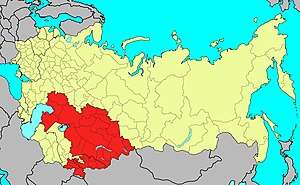Central Asian Military District
The Red Banner Central Asian Military District was a military district of the Soviet Armed Forces, which existed in 1926–1945 and 1969–1989, with its headquarters at Tashkent (1926–1945) and Almaty (1969–1989). By USSR Order No.304 of 4 June 1926, the Turkestan Front was renamed the Central Asian Military District.
| Central Asian Military District | |
|---|---|
 The territory of the Central Asian Military District in 1989. | |
| Active | 4 June 1926-9 July 1945 24 June 1969-1 June 1989 |
| Country | |
| Type | Military district |
| Headquarters | Tashkent (1926–1945) Almaty (1969–1989) |
| Engagements | World War II |
1st Formation
On 22 June 1941 the Central Asian Military District included the 4th Cavalry Corps (18th, 20th, and 21st Mountain Cavalry Divisions), the 27th Mechanised Corps (9th and 53rd Tank Divisions and 221st Mechanised Division, the 58th Rifle Corps, and the independent 238th Polish Rifle Division, as well as the Air Forces of the Central Asian Military District (under General Major M.P. Kharitonov, including 4th Aviation Brigade with 34th Bomber Aviation Regt (SBs) (Tashkent) and 116th Regiment (I-153s) at Stalinabad) and district troops.[1]
On 9 July 1945, the district was split into the Turkestan and Steppe Military Districts.
2nd Formation
The district was reformed in 1969, as the Chinese threat to the Soviet Union increased.
In 1988 the CAMD included the 32nd Army and 17th Army Corps and troops directly subordinate to district command. Air support was carried out by the 73rd Air Army, and air defence by the 12th and 14th Air Defence Armies. The 32nd Army (headquartered in Semipalatinsk) includes a tank and three motor rifle divisions, anti-aircraft and missile brigades, artillery and rocket regiments, separate Flame-tank Regiment, and others. The 17th Army Corps (headquartered in Frunze) included the 8th Guards Motor Rifle Division (Frunze) and the 68th Motor Rifle Division (Sary Ozek) (the former 372nd Rifle Division, 68th Mountain Motor Rifle Brigade (Osh), and the 30th independent Motor Rifle Regiment (Kurdai), plus a separate battalion.[2] District units included the 80th Guards Training Motor Rifle Division[3] and the 134th Motor Rifle Division (Dushanbe) (formed February 1980 to replace the 201st MRD which had been deployed to Afghanistan), two communications brigades, a chemical protection missile brigade, a separate air assault battalion, and the 23rd independent Helicopter Transport Regiment (Dushanbe).
In addition, the 57th Air Assault Brigade was based at Aktogay.
The district was disestablished and its territory incorporated into the Turkestan Military District from 5 January 1989.[4]
District commanders
- 1926—1928 — Konstantin Avksentevsky
- 1928—1933 — Pavel Dybenko
- 1933—1937 — Komkor Mikhail Velikanov
- 1937 — Komkor Ivan Gryaznov
- 1937 — Komandarm 2nd rank Aleksandr Loktionov
- 1937—1938 — Komkor Leonid Petrovsky
- 1938—1941 — Komkor Iosif Apanasenko
- 1941 — General Major Sergei Trofimenko,
- 1941 — June 1944 — Lieutenant General Pavel Kurbatkin
- Jul 1944 - May 1945 — (Acting) Major General Macarius Lipatov
- 24 Jun 1969 - 23 Nov 1977 - General of the Army Nikolay Grigorevich Lyashchenko[5]
- 24 Nov 1977 - 26 Nov 1980 - General Colonel Pyotr Georgievich Lushev
- 27 Nov 1980 - 26 Jun 1984 General Colonel Dmitri Yazov
- 27 Jun 1984 - 21 Jan 1987 - Colonel-General Vladimir Nikolaevich Lobov
- 22 Jan 1987 - 5 Jan 1989 - Colonel-General Aleksandr Vasilevich Kovtunov
References
- Leo Niehorster, Order of Battle, CAMD, 22 June 1941, Orbat.com.
- Feskov et al 2004, 61.
- Activated 25 June 1957 in Otar (Gvardeyskiy), Alma-Ata Oblast, as the 90th Guards Motorised Rifle Division, from the 16th Guards Mechanised Division.
- Holm, www.ww2.dk
- http://www.ww2.dk/new/army/gkv/savo.htm
Literature
- Military Encyclopedic Dictionary (Военный энциклопедический словарь), Moscow, 1984, 2002.
- V.I. Feskov, Golikov V.I., K.A. Kalashnikov, and S.A. Slugin, The Armed Forces of the USSR after World War II, from the Red Army to the Soviet (Part 1: Land Forces). (В.И. Слугин С.А. Вооруженные силы СССР после Второй Мировой войны: от Красной Армии к Советской (часть 1: Сухопутные войска)) Томск, 2013.